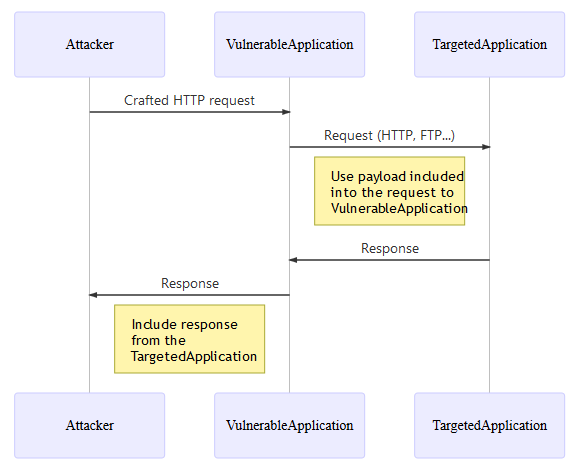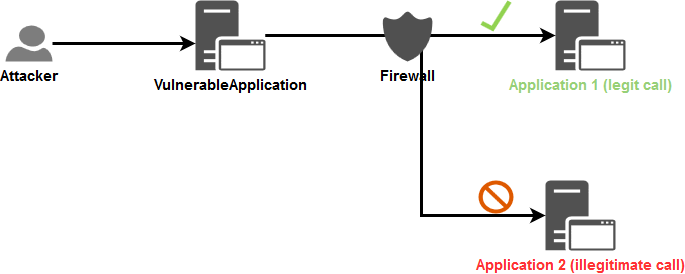
The objective of the cheat sheet is to provide advices regarding the protection against Server Side Request Forgery (SSRF) attack.
This cheat sheet will focus on the defensive point of view and will not explain how to perform this attack. This talk from the security researcher Orange Tsai as well as this document provide techniques on how to perform this kind of attack.
SSRF is an attack vector that abuses an application to interact with the internal/external network or the machine itself. One of the enablers for this vector is the mishandling of URLs, as showcased in the following examples:

Depending on the application's functionality and requirements, there are two basic cases in which SSRF can happen:
Because these two cases are very different, this cheat sheet will describe defences against them separately.
Sometimes, an application needs to perform a request to another application, often located on another network, to perform a specific task. Depending on the business case, user input is required for the functionality to work.
Take the example of a web application that receives and uses personal information from a user, such as their first name, last name, birth date etc. to create a profile in an internal HR system. By design, that web application will have to communicate using a protocol that the HR system understands to process that data. Basically, the user cannot reach the HR system directly, but, if the web application in charge of receiving user information is vulnerable to SSRF, the user can leverage it to access the HR system. The user leverages the web application as a proxy to the HR system.
The allowlist approach is a viable option since the internal application called by the VulnerableApplication is clearly identified in the technical/business flow. It can be stated that the required calls will only be targeted between those identified and trusted applications.
Several protective measures are possible at the Application and Network layers. To apply the defense in depth principle, both layers will be hardened against such attacks.
The first level of protection that comes to mind is Input validation.
Based on that point, the following question comes to mind: How to perform this input validation?
As Orange Tsai shows in his talk, depending on the programming language used, parsers can be abused. One possible countermeasure is to apply the allowlist approach when input validation is used because, most of the time, the format of the information expected from the user is globally known.
The request sent to the internal application will be based on the following information:
Note: Disable the support for the following of the redirection in your web client in order to prevent the bypass of the input validation described in the section Exploitation tricks > Bypassing restrictions > Input validation > Unsafe redirect of this document.
In the context of SSRF, validations can be added to ensure that the input string respects the business/technical format expected.
A regex can be used to ensure that data received is valid from a security point of view if the input data have a simple format (e.g. token, zip code, etc.). Otherwise, validation should be conducted using the libraries available from the string object because regex for complex formats are difficult to maintain and are highly error-prone.
User input is assumed to be non-network related and consists of the user's personal information.
//Regex validation for a data having a simple format if(Pattern.matches("[a-zA-Z0-9\\s\\-]", userInput)) //Continue the processing because the input data is valid >else //Stop the processing and reject the request > In the context of SSRF, there are 2 possible validations to perform:
The first layer of validation can be applied using libraries that ensure the security of the IP address format, based on the technology used (library option is proposed here to delegate the managing of the IP address format and leverage battle-tested validation function):
Verification of the proposed libraries has been performed regarding the exposure to bypasses (Hex, Octal, Dword, URL and Mixed encoding) described in this article.
Use the output value of the method/library as the IP address to compare against the allowlist.
After ensuring the validity of the incoming IP address, the second layer of validation is applied. An allowlist is created after determining all the IP addresses (v4 and v6 to avoid bypasses) of the identified and trusted applications. The valid IP is cross-checked with that list to ensure its communication with the internal application (string strict comparison with case sensitive).
In the attempt of validate domain names, it is apparent to do a DNS resolution to verify the existence of the domain. In general, it is not a bad idea, yet it opens up the application to attacks depending on the configuration used regarding the DNS servers used for the domain name resolution:
In the context of SSRF, there are two validations to perform:
Similar to the IP address validation, the first layer of validation can be applied using libraries that ensure the security of the domain name format, based on the technology used (library option is proposed here in order to delegate the managing of the domain name format and leverage battle tested validation function):
Verification of the proposed libraries has been performed to ensure that the proposed functions do not perform any DNS resolution query.
Example of execution of the proposed regex for Ruby:
domain_names = ["owasp.org","owasp-test.org","doc-test.owasp.org","doc.owasp.org", "",".owasp.org"] domain_names.each |domain_name| if ( domain_name =~ /^(((?!-))(xn--|_)?[a-z0-9-][a-z0-9]\.)*(xn--)?([a-z0-9][a-z0-9\-]|[a-z0-9-]\.[a-z])$/ ) puts "[i] #domain_name> is VALID" else puts "[!] #domain_name> is INVALID" end > $ ruby test.rb [i] owasp.org is VALID [i] owasp-test.org is VALID [i] doc-test.owasp.org is VALID [i] doc.owasp.org is VALID [!] is INVALID [!] .owasp.org is INVALID After ensuring the validity of the incoming domain name, the second layer of validation is applied:
Unfortunately here, the application is still vulnerable to the DNS pinning bypass mentioned in this document. Indeed, a DNS resolution will be made when the business code will be executed. To address that issue, the following action must be taken in addition of the validation on the domain name:
The following Python3 script can be used, as a starting point, for the monitoring mentioned above:
# Dependencies: pip install ipaddress dnspython import ipaddress import dns.resolver # Configure the allowlist to check DOMAINS_ALLOWLIST = ["owasp.org", "labslinux"] # Configure the DNS resolver to use for all DNS queries DNS_RESOLVER = dns.resolver.Resolver() DNS_RESOLVER.nameservers = ["1.1.1.1"] def verify_dns_records(domain, records, type): """ Verify if one of the DNS records resolve to a non public IP address. Return a boolean indicating if any error has been detected. """ error_detected = False if records is not None: for record in records: value = record.to_text().strip() try: ip = ipaddress.ip_address(value) # See https://docs.python.org/3/library/ipaddress.html#ipaddress.IPv4Address.is_global if not ip.is_global: print("[!] DNS record type '%s' for domain name '%s' resolve to a non public IP address '%s'!" % (type, domain, value)) error_detected = True except ValueError: error_detected = True print("[!] '%s' is not valid IP address!" % value) return error_detected def check(): """ Perform the check of the allowlist of domains. Return a boolean indicating if any error has been detected. """ error_detected = False for domain in DOMAINS_ALLOWLIST: # Get the IPs of the current domain # See https://en.wikipedia.org/wiki/List_of_DNS_record_types try: # A = IPv4 address record ip_v4_records = DNS_RESOLVER.query(domain, "A") except Exception as e: ip_v4_records = None print("[i] Cannot get A record for domain '%s': %s\n" % (domain,e)) try: # AAAA = IPv6 address record ip_v6_records = DNS_RESOLVER.query(domain, "AAAA") except Exception as e: ip_v6_records = None print("[i] Cannot get AAAA record for domain '%s': %s\n" % (domain,e)) # Verify the IPs obtained if verify_dns_records(domain, ip_v4_records, "A") or verify_dns_records(domain, ip_v6_records, "AAAA"): error_detected = True return error_detected if __name__== "__main__": if check(): exit(1) else: exit(0) Do not accept complete URLs from the user because URL are difficult to validate and the parser can be abused depending on the technology used as showcased by the following talk of Orange Tsai.
If network related information is really needed then only accept a valid IP address or domain name.
The objective of the Network layer security is to prevent the VulnerableApplication from performing calls to arbitrary applications. Only allowed routes will be available for this application in order to limit its network access to only those that it should communicate with.
The Firewall component, as a specific device or using the one provided within the operating system, will be used here to define the legitimate flows.
In the schema below, a Firewall component is leveraged to limit the application's access, and in turn, limit the impact of an application vulnerable to SSRF:

Network segregation (see this set of implementation advice can also be leveraged and is highly recommended in order to block illegitimate calls directly at network level itself.
This case happens when a user can control a URL to an External resource and the application makes a request to this URL (e.g. in case of WebHooks). Allow lists cannot be used here because the list of IPs/domains is often unknown upfront and is dynamically changing.
In this scenario, External refers to any IP that doesn't belong to the internal network, and should be reached by going over the public internet.
Thus, the call from the Vulnerable Application:
Based on the business requirements of the above mentioned applications, the allowlist approach is not a valid solution. Despite knowing that the block-list approach is not an impenetrable wall, it is the best solution in this scenario. It is informing the application what it should not do.
Here is why filtering URLs is hard at the Application layer:
Taking into consideration the same assumption in the following example for the following sections.
Like for the case n°1, it is assumed that the IP Address or domain name is required to create the request that will be sent to the TargetApplication.
The first validation on the input data presented in the case n°1 on the 3 types of data will be the same for this case BUT the second validation will differ. Indeed, here we must use the block-list approach.
Regarding the proof of legitimacy of the request: The TargetedApplication that will receive the request must generate a random token (ex: alphanumeric of 20 characters) that is expected to be passed by the caller (in body via a parameter for which the name is also defined by the application itself and only allow characters set [a-z] ) to perform a valid request. The receiving endpoint must only accept HTTP POST requests.
Validation flow (if one the validation steps fail then the request is rejected):
Similar to the following section.
In cloud environments SSRF is often used to access and steal credentials and access tokens from metadata services (e.g. AWS Instance Metadata Service, Azure Instance Metadata Service, GCP metadata server).
IMDSv2 is an additional defence-in-depth mechanism for AWS that mitigates some of the instances of SSRF.
To leverage this protection migrate to IMDSv2 and disable old IMDSv1. Check out AWS documentation for more details.
Semgrep is a command-line tool for offline static analysis. Use pre-built or custom rules to enforce code and security standards in your codebase. Checkout the Semgrep rule for SSRF to identify/investigate for SSRF vulnerabilities in Java https://semgrep.dev/salecharohit:owasp_java_ssrf
Online version of the SSRF bible (PDF version is used in this cheat sheet).
Articles about SSRF attacks: Part 1, part 2 and part 3.
Mermaid code for SSRF common flow (printscreen are used to capture PNG image inserted into this cheat sheet):
sequenceDiagram participant Attacker participant VulnerableApplication participant TargetedApplication Attacker->>VulnerableApplication: Crafted HTTP request VulnerableApplication->>TargetedApplication: Request (HTTP, FTP. ) Note left of TargetedApplication: Use payload included
into the request to
VulnerableApplication TargetedApplication->>VulnerableApplication: Response VulnerableApplication->>Attacker: Response Note left of VulnerableApplication: Include response
from the
TargetedApplication Draw.io schema XML code for the "case 1 for network layer protection about flows that we want to prevent" schema (printscreen are used to capture PNG image inserted into this cheat sheet).
©Copyright - Cheat Sheets Series Team - This work is licensed under Creative Commons Attribution-ShareAlike 4.0 International.